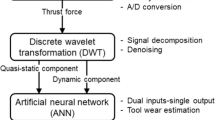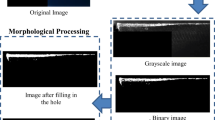Abstract
Drill wear not only affects the surface smoothness of the hole, but also influences the life of the drill. Drill wear state recognition is important in the manufacturing process, which consists of two steps: first, decomposing cutting torque components from the original signals by wavelet packet decomposition (WPD); second, extracting wavelet coefficients of different wear states (i.e., slight, normal, or severe wear) with signal features adapting to Welch spectrum. Finally, monitoring and recognition of the feature vectors of cutting torque signal are performed by using the K-means cluster and radial basis function neural network (RBFNN). The experiments on different tool wears of the multivariable features reveal that the results of monitoring and recognition are significant and effective.
Similar content being viewed by others
References
Y. J. Choi, M. S. Park, C. N. Chu. Prediction of drill failure using features extraction in time and frequency domains of feed motor current. International Journal of Machine Tools and Manufacture, vol. 48, no. 1, pp. 29–39, 2008.
B. Sick. On-line and indirect tool wear monitoring in turning with artificial networks: A review of more than a decade of research. Mechanical Systems and Signal Processing, vol. 16, no. 4, pp. 487–546, 2002.
A. Noori-Khajavi, R. Komanduri. Frequency and time domain analyses of sensor signals in drilling, Part 1: Correlation with drill wear. International Journal of Machine Tools and Manufacture, vol. 35, no. 6, pp. 775–793, 1995.
A. L. Quadro, J. R. T. Branco. Analysis of the acoustic emission during drilling test. Surface and Coating Technology, vol. 94–95, no. 1–3, pp. 691–695, 1997.
Y. T. Oh, W. T. Kwon, C. N. Chu. Drilling torque control using spindle motor current and its effect on tool wear. International Journal of Advanced Manufacturing Technology, vol. 24, no. 5–6, pp. 327–334, 2004.
N. Kasashima, K. Mori, G. H. Ruiz, N. Taniguchi. On-line failure detection in face milling using discrete wavelet transform. CIRP Annals — Manufacturing Technology, vol. 44, no. 1, pp. 483–487, 1995.
V. Perlibakas. Face recognition using principal component analysis and wavelet packet decomposition. Informatica, vol. 15, no. 2, pp. 243–250, 2004.
Z. X. Xiong, K. Ramchandran, M. T. Orchard. Wavelet packet image coding using space-frequency quantization. IEEE Transactions on Image Processing, vol. 7, no. 6, pp. 892–898, 1998.
M. Cocchi, R. Seeber, A. Ulrici. WPTER: Wavelet packet transform for efficient pattern recognition of signals. Chemometrics and Intelligent Laboratory Systems, vol. 57, no. 2, pp. 97–119, 2001.
B Liu. Selection of wavelet packet basis for rotating machinery fault diagnosis. Journal of Sound and Vibration, vol. 284, no. 3–5, pp. 567–582, 2005.
J. A. Hartigan, M. A. Wong. Algorithm AS 136: A K-means clustering algorithm. Applied Statistics, vol. 28, no. 1, pp. 100–108, 1979.
A. Juan, E. Vidal. Fast K-means-like clustering in metric spaces. Pattern Recognition Letters, vol. 15, no. 1, pp. 19–25, 1994.
T. Kanungo, D. M. Mount, N. S. Netanyahu, C. D. Piatko, R. Silverman, A. Y. Wu. An efficient K-means clustering algorithm: Analysis and implementation. IEEE Transactions on Pattern Analysis and Machine Intelligence, Vol. 24, no. 7, pp. 881–892, 2002.
I. Abu-Mahfouz. Drilling wear detection and classification using vibration signals and artificial neural network. International Journal of Machine Tools and Manufacture, vol. 43, no. 7, pp. 707–720, 2003.
P. G. Li, S. M. Wu. Monitoring drilling wear states by a fuzzy pattern recognition technique. Journal of Engineering for Industry — Transactions of the ASME, vol. 110, no. 3, pp. 297–300, 1988.
R. K. Dutta, S. Paul, A. B. Chattopadhyay. Applicability of the modified back propagation algorithm in tool condition monitoring for faster convergence. Journal of Materials Processing Technology, vol. 98, no. 3, pp. 299–309, 2000.
E. Govekar, I. Grabec. Self-organizing neural network application to drill wear classification. Journal of Engineering for Industry — Transactions of the ASME, vol. 116, no. 2, pp. 233–238, 1994.
T. Obikawa, J. Shinozuka. Monitoring of flank wear of coated tools in high speed machining with neural network ART2. International Journal of Machine Tools and Manufacture, vol. 44, no. 12–13, pp. 1311–1318, 2004.
M. Chen, C. S. Jiang, Q. X. Wu. Sensor fault diagnosis for a class of time delay uncertain nonlinear systems using neural network. International Journal of Automation and Computing, vol. 5, no. 4, pp. 401–405, 2008.
C. C. Tsao. Prediction of flank wear of different coated drills for JIS SUS 304 stainless steel using neural network. Journal of Materials Processing Technology, vol. 123, no. 3, pp. 354–360, 2002.
P. Welch. The use of fast Fourier transform for the estimation of power spectra: A method based on time averaging over short, modified periodograms. IEEE Transactions on Audio and Electroacoustics, vol. 15, no. 2, pp. 70–73, 1967.
Author information
Authors and Affiliations
Corresponding author
Additional information
Xu Yang received M. Tech. degree in mechanical engineering from Dalian Polytechnic University, Dalian, PRC in 2005. He has been a lecturer of Dalian Polytechnic University. Currently, he is a Ph.D. candidate in the Department of Mechanical System Engineering at Faculty of Engineering of Gunma University, Kiryu, Japan.
His research interests include mechanical automation, artificial intelligence, and virtual instrument.
Rights and permissions
About this article
Cite this article
Yang, X. Wear state recognition of drills based on K-means cluster and radial basis function neural network. Int. J. Autom. Comput. 7, 271–276 (2010). https://doi.org/10.1007/s11633-010-0502-z
Received:
Revised:
Published:
Issue Date:
DOI: https://doi.org/10.1007/s11633-010-0502-z




